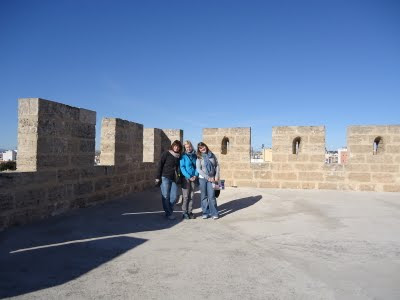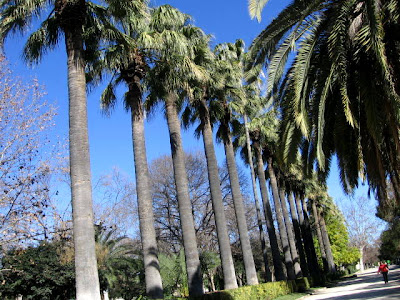"A man travels the world overin search of what he needs
and returns home to find it."
~George Moore
Slovenia, officially the Republic of Slovenia, is a young country in Central Europe touching the Alps and bordering the Mediterranean.
Slovenia borders Italy on the west, the Adriatic Sea on the southwest, Croatia on the south and east, Hungary on the northeast, and Austria on the north.
Although Slovenia's total surface area is only around 20,000 km2,
it has almost 10,000 km2 of forest.
And in all that forest over 400 brown bears make their home...
...still there is place for other visitors...
Slovenia has over 7,000 km of marked mountain trails.
Plenty of place to enjoy the nature...
-Velika Planina-
-Bohinj lake-
-Triglav: the highest mountain, 2864m-
-Bled lake-
If you want to do something extreme...
Soča valey is the right place to do it.
Or you can just enjoy in good wine and food.
-Pršut-
Slovenia is covered with vineyards.
Old Vine in Maribor is over 400 years old and it is the oldest vine in the world.
-"Old Vine" in Maribor city-
The Old vine is the most significant world record that Maribor holds. It is the pride of the city and Slovenia. "Stara trta" (in Slovenian) is the oldest living example of a noble vine on our planet.
Vine and tradicion conected with it is important part of slovenian culture.
-"Putarji" : photo of famous slovenian photographer Stojan kebler-
Postojna Cave, part of Slovenia’s Karst region, is the most-visited cave in Europe.
-Postojna cave-
-Postojna cave has a very special inhabitants: human fish or Proteus Anguinus-
In Karst area you can find plenty of caves...
-Škocjan cave-
-Rakov skocjan-
And if you prefer life above the surface you can visit one of many castels.
-Predjamski grad-
-Otocec-
-Bled-
And you can not miss our capital:
LJUBLJANA
With its 280.000 inhabitants, Ljubljana most certainly ranks among the smaller European capitals.
For centuries, Ljubljana was the capital of the historical region of Carniola and in the 20th century it became the cultural, educational, economic, political an administrative centre of Slovenia, independent since 1991.
Its transport connections, concentration of industry, scientific and research institutions and cultural tradition are contributing factors to its leading position.
The Ljubljana dragon is the symbol of the city.
It symbolises strength, courage and might. It is depicted on the Dragon Bridge and on top of the castle tower on Ljubljana’s coat of arms. The Ljubljana dragon may have its origins in the legend of Jason and the Argonauts.
-Dragon bridge in Ljubljana-
But Ljubljana is not the only city wort visiting....
On one side of the country you can find beautiful coastline with acient cityes like Piran...
 -Piran-
-Piran-
 -Piran-
-Piran-
 - The Secovlje saltpans, more than 700 years old.-
- The Secovlje saltpans, more than 700 years old.-
-Portoroz-
...and on the other...
 -Maribor-
-Maribor-
-Ptuj-
...still keep in mind the distance between is no more then 300km.
So in the morning you can ski in Alps:
-Vogel ski resort-
And in the afternoon relax in Spa in Ptuj:
-Terme Ptuj-
______________________________________________________
All that in company of 2 milions
 beautiful ladies
beautiful ladies
and charming gentelmans :)
Slovenian flag
History...
The history of Slovenia has seen many occupations, including those by Roman Empire, Byzantine Empire, Republic of Venice, Duchy of Carantania, Holy Roman Empire, Habsburg Monarchy, Austrian Empire, State of Slovenes, Croats and Serbs, Kingdom of Serbs, Croats and Slovenes, and the Socialist Federal Republic of Yugoslavia. Today, it is an independent country, boasting of high rates of growth and progress..."Since 1550, when the Protestant Primož Trubar penned the word Slovenes for the first time, a common Slovenian national identity has slowly developed.
The idea of Slovenia only emerged in 1843, whereas the first national programme was drawn up by a group of a few Slovenian intellectuals in 1848. The Slovenes lived in lands historically ruled over by the Austrians that were marked by a strong regional identity and an ethic mix.
The eastern part of the Slovenian territory developed independently in the Hungarian part of the monarchy, with the local Slovenes (Prekmurians) developing their own language. By introducing compulsory lower primary schooling, the Hapsburg Monarchy enabled the Slovenes to survive as a nation, while preventing them from achieving political autonomy. With the downfall of the monarchy, the majority of Slovenes joined the Yugoslav state, although the entire western territory encompassing a third of the Slovenian population remained under Italy, the northern part (Carinthia) under Austria, with the eastern part being divided between Yugoslavia and Hungary, with the former receiving the larger part (Prekmurje) and the latter the smaller one (the Raba region). All minorities were quickly subjected to assimilation, initially and particularly the people of Primorska, under fascist rule. In the Kingdom of Yugoslavia, the Slovenes made economic and cultural gains and also acquired their first university; however, they failed to achieve their main goal: political autonomy.
By resisting the German, Italian and Hungarian occupying forces, the Slovenes managed to survive as a nation, achieved a change of the western border and the status of a Republic in the Yugoslav socialist federation. They had their own assembly (parliament), government (executive council), after the Constitution of 1974 a collective republic presidency and after 1946 under all state and republic constitutions a right to self-determination, including the right to secession."
Dr. Božo Repe

"The status of an independent state offers Slovenia a considerably better position than it would have had if, given the favourable development of events, Yugoslavia had actually reformed itself and entered the EU as a single state. In this case, Slovenia would have only been one of its regions. Currently, Europe shows the will to together resolve the global financial crisis and retain the established integration levels. One can only hope it will pass this test. At the same time, nation-states still represent a significant protection factor. Slovenia has already overtaken the average EU GDP, and even overtaken some of the older member states, while still somehow managing to retain its social state model. It is a modern state with a well-diversified education system along with developed, widely accessible information technologies and good road connections (and a terribly out-dated railway system). It is one of the ecologically better developed states, has a low crime rate and offers its inhabitants a comfortable and quality life."
Dr. Božo Repe
 Slovenian euro coins were first issued for circulation on 1 January 2007.
Slovenian euro coins were first issued for circulation on 1 January 2007.
-national hymn: Zdravljica by greatest poet France Prešeren-
Official language is Slovenian. (Slovenščina)
However, by law they are bilingual on the coast: Slovenian and Italian
and in the area near the Austrian border: Slovenian and German.
The Slovenian coat of arms consists of a red bordered blue shield on which there is a stylised white mount Triglav. Under Triglav there are two bending lines that represent the sea and rivers, and above Triglav there are three golden, six-pointed stars, forming a triangle. The stars are taken from the coat of arms of the counts of city Celje.
___________________________________________________________
There is no place like home!!!
Tanja Veg





































































































